
Category: New-Music Mondays
Mondays spotlight new and recent recordings of special merit.
Q & A with Karen Gomyo
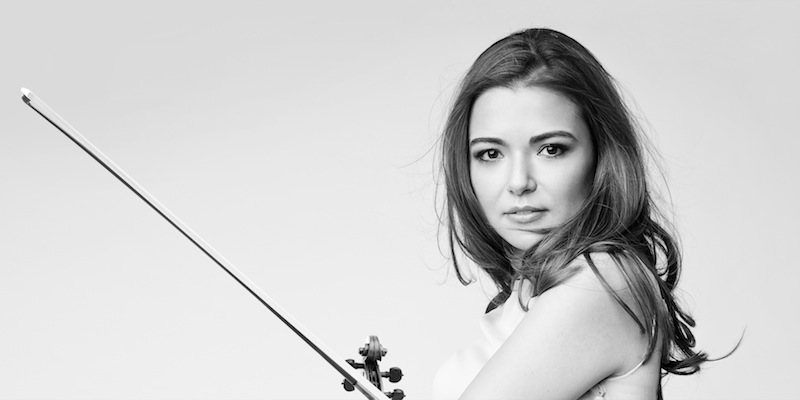
Karen Gomyo was born in Tokyo, but grew up in Montréal. That is, up to the point when, at age 10, she moved to New York City, in order to study at the Juilliard School, at the invitation of Dorothy DeLay. Miss DeLay taught, among many others, my friends Arturo Delmoni and David Kim. Indeed, it’s the rare household-name violinist of the last 50 years whom Miss DeLay did not teach.
Miss Gomyo continued her studies at the Indiana University Jacobs School of Music (yay!) and the New England Conservatory. Apart from Miss DeLay, her teachers included Mauricio Fuks, Donald Weilerstein, and cellist Heinrich Schiff.
In addition to the standard concert repertoire, Miss Gomyo has a great affinity for the music of Astor Piazzolla, and has performed with the late Piazzolla’s former colleagues Pablo Ziegler (whose solo recording on the Steinway & Sons label can be heard here), Hector del Curto (bandoneon), Claudio Ragazzi (electric guitar), and Pedro Giraudo (double bass).
Miss Gomyo has followed up her recording of the Bo Linde violin concerto with an SACD of music for the wonderful combination of violin and classical guitar, which I reviewed last post. Questions and answers after the jump. Continue Reading →
Karen Gomyo and Ismo Eskelinen: Carnival (music for violin and guitar) (SACD)
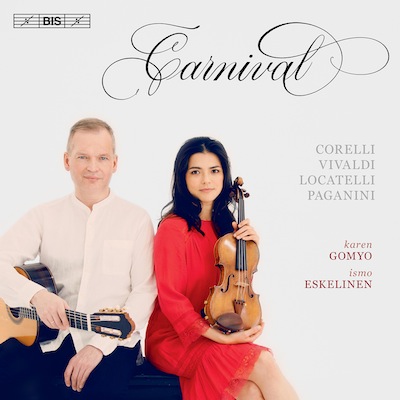
Karen Gomyo and Ismo Eskelinen: Carnival
Music for violin and guitar of Corelli, Vivaldi, Locatelli, and Paganini.
SACD (BIS 1998) and MP3 downloads available from Amazon
Hi-Res downloads (24-bit/96kHz stereo AIFF, ALAC, FLAC, and WAV) available from e-classical and HDTracks
Streaming available from Tidal (and others)
Release date: November 1, 2019
Recorded September 2015 at Troy Savings Bank Music Hall, New York. Producer and recording engineer: Hans Kipfer (Take5 Music Production). Violin by Antonio Stradivari, the ‘Aurora’ (1703); bow by François Tourte (c. 1810); Guitar by Gabriele Lodi (2011). Total time 67 min. 30 sec.
It used to be that only hard-core violin nerds were aware that legendary violinist Niccolò Paganini (1782-1840) played the classical guitar, or that he also composed a substantial body of works for that instrument. Superb recordings such as this one can only increase recognition of that intriguing fact.
This recording places works by Paganini (and a selection of his “Carnival of Venice” variations, with the addition of a new variation by Miss Gomyo) in the context of earlier works by Paganini’s violinist/composer predecessors Corelli, Vivaldi, and Locatelli, who were born in 1653, 1678, and 1695, respectively.
For the earlier Baroque sonatas, the guitarist on this recording, Ismo Eskelinen, created guitar parts from the original basso-continuo parts. But even in the Baroque era, the guitar’s predecessor the lute was a continuo instrument as well as a solo instrument (and also the instrument in the duo genre known as the “lute song”).
For those of us who remember the dawn of the CD medium (I was the founding classical-music columnist of Digital Audio magazine, which was later rebranded as CD Review), mention of the recording venue for this recording should bring a flood of warm memories. The venue for this project was Troy, New York’s Troy Savings Bank Music Hall, which was for many years where Dorian Recordings did most of their work. More information, and sound bytes, after the jump. Continue Reading →
Cole Porter on a Steinway, vol. 1
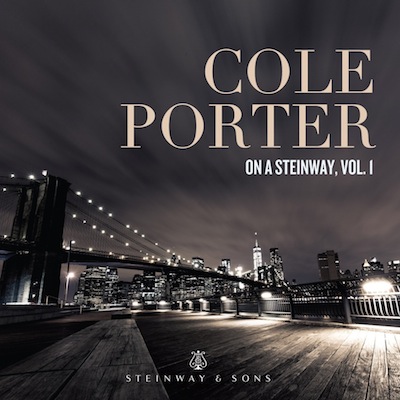
Various: Cole Porter on a Steinway, vol. 1
Solo-piano transcriptions of show tunes by Cole Porter
Steinway & Sons catalog number 30116
Release date: December 6, 2019
Recorded at Steinway Hall, New York City, July 2014-April 2019.
Well, here’s a real winner!
Steinway & Sons’ piano recordings—especially the ones that they themselves produce and engineer at the new Steinway Hall performance and recording facility in New York City—are of reliably superb audio quality. That said, I hasten to point out that Steinway’s releases that were not recorded in Steinway Hall are often (but not always) just as good in terms of sound quality; they are merely “different.”
I think that the Steinway recordings made at the Shalin Liu performance hall in Rockport, Massachusetts are objectively as “good” as the Steinway Hall ones. Subjectively, I have a (slight) personal preference for the slightly more distant and bloom-y sound of Shalin Liu. If anyone prefers the slightly more in-focus Steinway Hall sound, I will not lose any sleep.
I also must point out that the sonic differences I am noting (and such is the case with many audio differences) are minor; they might not reveal themselves to casual listeners who only give a casual listen.
By this point, Steinway has released well over 100 CDs. Not all of them have totally won me over to their artistic standpoints (of course, such are matters of taste, and you are free to disagree). But… when the stars and planets line up as they do here… Wow!
This collection of solo-piano treatments of famous Cole Porter show tunes (by three different pianists, Adam Birnbaum, Jed Distler, and Simon Mulligan) presents, in spot-on high-resolution (24/96) sound, standout Cole Porter interpretations that range from the wistful and pensive to the liltingly bouncy. All delivered via sloshingly-full buckets of piano technique and always with a refined musical taste that might have made Cole Porter smile.
You can hear the entire album right now, at no charge via Steinway Streaming.
Cole Porter on a Steinway, Vol. 1 goes on sale December 6, 2019 (downloads only; mp3 on Amazon; 24/96 FLAC on HDTracks).
More pensations, and sound samples, after the jump. Continue Reading →
Steinway & Sons Streaming: An Excellent No-Cost Music Source
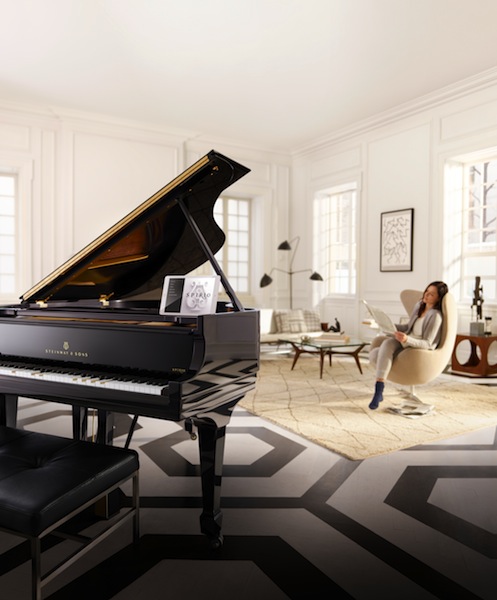 Steinway & Sons’ Spirio Playback Piano.
Steinway & Sons’ Spirio Playback Piano.
Image courtesy of Steinway.
I felt a rueful twinge when legendary piano builder Steinway & Sons took itself private and as a result was de-listed from the New York Stock Exchange. My nostalgic or sentimental reason was that Steinway & Sons’ NYSE stock-ticker symbol long had been LVB, an homage to Ludwig van Beethoven. Beethoven’s piano sonatas are generally regarded as the distilled essence of greatness in piano music.
Apart from that, as far as I can tell, jumping out of the goldfish bowl that is the NYSE has done wonders for Steinway. In 2014, Steinway came out with the Spirio, a piano (available in two sizes) that includes the most sophisticated piano-playback technology (a non-MIDI system) ever to reach commercial critical mass. More recently, Steinway has begun offering a record-and-playback version of the Spirio. Steinway’s biggest challenge at the moment is building enough Spirio pianos to meet the demand. Good for them.
Under New Management, Steinway also launched their own CD label (they have also released a few SACDs). They embarked upon an ambitious recording agenda, for which they built a new, state-of-the-art performance-and-recording hall. So that you can hear the complete recordings before you buy the CDs or download the audio files, Steinway has created a dedicated streaming site that offers commercial-free play of complete albums from Steinway & Sons Recordings. There are also informative reviews posted for many of the albums. Steinway & Sons CDs are available from Amazon; hi-res files, from 24/44.1 to 24/192 (varying by title) are available from HDTracks.
I asked Eric Feidner, Steinway’s VP for Music, Media, and Technology, to tell me about what “getting into the record business” has meant for the 166-year old firm.
At Steinway, our very long history with performing artists goes back to the 1800s, with legendary pianists such as Anton Rubinstein and Ignace Paderewski. In recent decades, the “Steinway Artist” program has been a central part of the company. We started the record label about 10 years ago as a natural outgrowth of our relationships with Steinway Artists.
As we moved into the development of the Steinway Spirio, we faced a critical need to create a catalog of “high resolution” music to embed in the world’s finest player piano—we send our Spirio owners new playlists every month. Because there was no such content available elsewhere, we had to build our own. There are now close to 4,000 works in the Spirio catalog.
The Spirio piano’s development and the Spirio catalog’s development processes inevitably became symbiotic with the record label, as through these, we developed techniques to produce commercial audio recordings with far greater efficiency and with remarkably consistent levels of technical and sonic quality. Making recordings and building pianos are now very closely intertwined at Steinway & Sons.
After the jump, recommendations for a baker’s dozen (13) great CDs that you can hear in their entirety at no cost! Continue Reading →
Christmas Music (Part 4): ORA Singers: “The Mystery of Christmas”
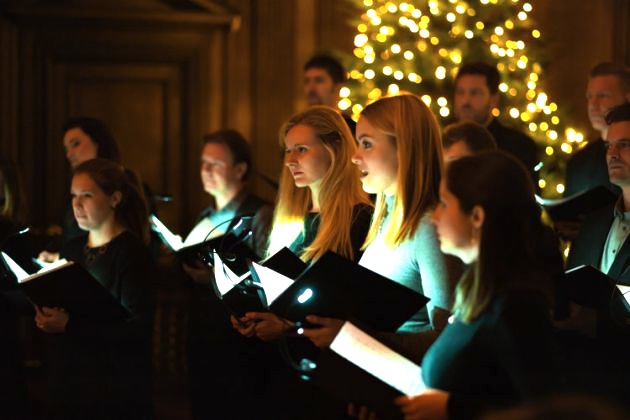
ORA Singers: The Mystery of Christmas
Music of Allain, Anonymous, Byrd, Hall, Hyde, Lauridsen, Macmillan,
McDowall, Peacock, Rowarth, Rutter, Samitz, Sixten, Tallis, Williams, and Weir.
CD Harmonia Mundi HMM 905303
Downloads (24-bit/96kHz stereo AIFF, ALAC, FLAC, and WAV) available from HDTracks.
Streaming available from Tidal.
Recorded at St. Augustine’s Church, Kilburn, London, January 23-28 and August 7-12, 2017. Nicholas Parker (all tracks except track 5) and Tim Handley (track 5 only), producers; Mike Hatch, engineer. Support for the arts from the Pureland Foundation. Total time 76’37.
My previous Christmas-music recommendations can be found here: Part 1; Part 2; and Part 3.
Here’s a fantastic new recording from a group new to me, Suzi Digby’s ORA Singers. They are as good as any handpicked professional choral ensemble out there. (I have heard most of the top ones live.) This collection showcases ORA’s “Unique Selling Proposition,” which is to prove that today, we are in a Golden Age not only of choral singing, but also of composing works for vocal ensembles. (Funny; I have long said the exact same thing about the art of the string quartet. We live in a golden age of the string quartet—both for playing and for new works.)
Therefore, ORA’s (for lack of a better phrase) business plan is to commission 100 new works for chorus over the course of ten years. (They are well on their way to achieving that goal, having commissioned 40 works in three years.) To make it even more interesting, Ms. Digby’s approach is to ask today’s composers to create works that are personal reflections upon the choral glories of the past, especially the masterworks of the Renaissance. Ambitious, yes. But several of the new works on this disc should find their ways into the standard repertory fairly quickly.
As a producer of classical recordings, one of my favorite Shibboleths (or, rubrics or axioms) long has been that, once your CD has started playing in the CD player of the reviewer, radio programmer, or record-store buyer, you have only ten seconds to make the sale. Furthermore, I believe that you make the sale only by giving the listener that “You are in good hands with Allstate” feeling. If the listener gets the feeling that your performance is for you a nerve-racking tightrope walk, no sale. (Obviously, there are exceptions to my little rule. Not much at all happens in the first ten seconds of Mahler’s Symphony 1; at least, not much by which you can distinguish a great performance from one that is merely unobjectionable.) In the case of the ORA Singers’ The Mystery of Christmas, convincing me took only the first four to eight seconds of the first track.
More information, a performance video, and sound bytes from The Mystery of Christmas after the jump. Continue Reading →
Stile Antico: De Victoria, Tenebrae Responsories for Holy Week
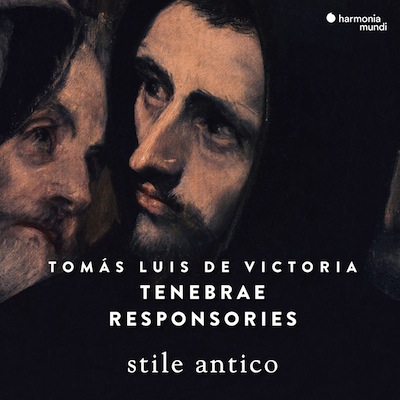
Stile Antico:
Tomás Luis de Victoria, Tenebrae Responsories for Holy Week
CD Harmonia Mundi HMM 902272
Downloads (24-bit/88kHz AIFF, ALAC, FLAC, and WAV stereo) available from HDTracks.
Streaming available from Tidal and Apple Music.
Recorded at All Hallows’ Church, Gospel Oak (North London) England, February 13-17, 2017. Robina G. Young, producer; Brad Michel, engineer.
The British early-music group that calls itself “Stile Antico” once again proves that they are, without doubt, one of the most impressive vocal ensembles before the public today. I Imagine that their group name just might be a bit of an insider’s joke—stile antico is a musical term used (from the early 1600s on) to characterize the continued creation of new but historically-conscious “old style” music.
The composers of stile antico music declined to embrace the emerging Baroque stylistic trends of increasingly elaborate ornamentation and more complex (and freer) counterpoint. Stile antico composers regarded the works of older composers (especially Palestrina) as ideals that could not be surpassed—a position that was still being put forward (believe it or not) even as late as the 1870s (at least in the realm of sacred music)… .
The group Stile Antico’s “Unique Selling Proposition” is that they work without a conductor or music director, in this regard being more like a chamber-music instrumental ensemble than an orchestra. While this might seem a very daunting prospect, I think that with so much of the repertory being four-part scores (two high voices and two low voices), hashing things out should be no more difficult than, say, when a string quartet’s members decide among themselves how a movement (such as the slow movement of Beethoven’s op. 127) should be played. (Irony alert.)
I was rather agog at Stile Antico’s 2006 début SACD Music for Compline when I wrote about it for Stereophile magazine, and they have continued at that high level for more than 10 years. Their articulation, phrasing, and ensemble work are among the best; but what really sets them apart is the lush richness of their vocal sound. Arkivmusic.com has Stile Antico’s Music for Compline on offer at $9.99, which I gather is a 10th-anniversary non-SACD CD reissue. That one’s a no-brainer. Just buy it. The o.o.p. SACD version is available from third-party sellers on Amazon, at prices ranging from market-correct to delusional. (But I did tell Stereophile‘s readers to just buy that, more than 10 years ago.)
After the jump: a making-of video of Stile Antico’s Tenebrae Responsories, some background and commentary, and a few sound bytes. Continue Reading →
Schola Sanctæ Sunnivæ: Chant from the Fingergull Manuscript
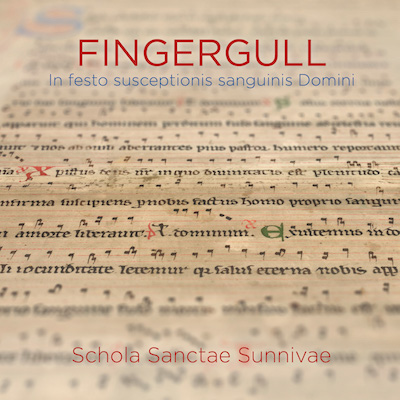
Schola Sanctæ Sunnivæ:
FINGERGULL – In festo susceptionis sanguinis Domini
SACD/CD 2L-114-SACD
Downloads (MP3 stereo; CDQ FLAC stereo; high-resolution stereo including
MQA, DXD PCM, and DSD; and 5.1 surround-sound) available from www.2L.no
Streaming available from Tidal and Spotify.
Recorded at Ringsaker Church, Norway, May 2014. Prof. Eugeen Liven d’Abelardo, producer and musical advisor; Beatrice Johannessen, recording engineer; Morten Lindberg, mastering engineer.
Christianity was the original “New Age” movement. Because of that, perhaps the easiest way for most listeners to take in this extraordinary recording of an a-cappella female vocal ensemble chanting music from a 13th-century parchment manuscript might be to think of it as “New Age Music,” and then just leave it at that.
I hereby give you permission to ignore the specific historical context of this music, and to concentrate on letting the enveloping and consoling, nearly weightless clarity of the unison female voices wash over you.
I would expect that within minutes, you might begin to feel yourself transported—if not to a higher realm, then at least to a safe and quiet place… perhaps to a medieval church rather like the one where this remarkable recording was made.
For many years, I would say about such a recording, “Just buy it.” And for many listeners, that still makes the most sense, in that this release is a compatible hybrid multichannel SACD, and furthermore, there are high-resolution downloads available for purchase. But I recognize that many music lovers now rely upon a streaming service as their major source of new music, so I am glad to report that this recording can be heard via on-demand streaming from Tidal and also Spotify.
Session photo, sound samples, and more, after the jump link. Continue Reading →
Adam Schoenberg: “Finding Rothko” and other orchestral works
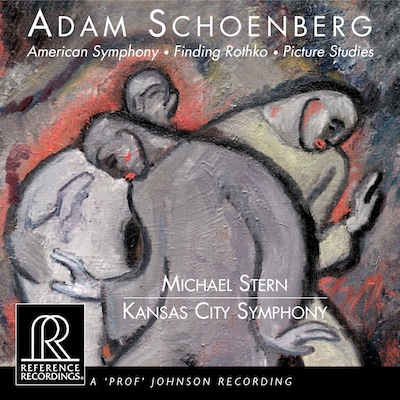
Adam Schoenberg: Finding Rothko, American Symphony, and Picture Studies.
Kansas City Symphony, Michael Stern, conductor.
Reference Recordings RR-139 Hybrid+MCH SACD and Downloads
David Frost, producer; Keith O. Johnson, engineer and mastering engineer.
My recent entry on the Morton Feldman musical work inspired by Houston’s Rothko Chapel noted that Rothko’s huge canvasses displayed there had also inspired Peter Gabriel’s song “Fourteen Paintings.” Four different Mark Rothko paintings that span the years 1949 to 1959 more recently inspired American composer Adam Schoenberg (b.1980) to write Finding Rothko, an orchestral work in four movements identified by the colors Orange, Yellow, Red, and Wine. Finding Rothko is concise, tonal, melodic, and accessible, with brilliant orchestration.
The obvious parallel is to Arthur Bliss’ A Colour Symphony of 1922 (which perhaps was an un-acknowledged inspiration). A Colour Symphony‘s movements are also named after colors; in Bliss’ case, the heraldic colors Purple, Red, Blue, and Green.
More ponderings and generous sound samples after the jump. Continue Reading →
Brahms: The Four Symphonies; Boston Symphony Orchestra, Andris Nelsons
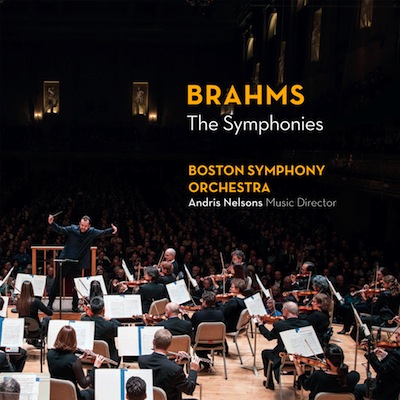
Brahms: The Four Symphonies
Boston Symphony Orchestra, Andris Nelsons
3-CD set and Downloads from BSO Classics
(Downloads are: 320 Kbs mp3; 24/96 AIFF; and 24/96 and 24/192 FLAC.)
Shawn Murphy, Producer and Engineer; Nick Squire, Recording Engineer; Robert Wolff, Editing Engineer; Tim Martyn, Editing Engineer and Mastering Engineer; Joel Watts and John Morin, Assistant Engineers; Brian Losch and Silas Brown, Production Assistants.
This review will be brief—but imperative. The official (so to speak) start of Andris Nelsons’ tenure as Music Director of the Boston Symphony Orchestra was a performance of the Overture to Richard Wagner’s Tannhäuser. The first CD I reviewed on this blog included that live recording, made the evening of September 27, 2014. (The other work on that CD is Sibelius’ second symphony, recorded later in Nelsons’ first season.) Furthermore, I named my blog after a Tannhäuser reference in the movie Blade Runner. So, all the breadcrumbs have been in plain sight; you should not be surprised that I am predisposed to be well-disposed to any and all new recordings from Andris Nelsons.
And it is not just this particular Humble Ink-Stained Wretch of the Fourth Estate who thinks the world of young Maestro Nelsons, either. Two CDs from Nelsons’ and the BSO’s ongoing Shostakovich series have won back-to-back Grammy awards in the category of Best Orchestral Performance. The BSO’s new 3-CD Brahms set is of that caliber.
By all means, you should click on the jump link for more detail, sound bytes, and some measure of justification. But the bottom line is: If the symphonies of Brahms are important to you, you should buy these CDs (or downloads), immediately. Taking into account interpretation, playing, and recorded sound, this set shoots right up into the top tier of recommendations in this music. Continue Reading →
Camilla Tilling: “loves me… loves me not…” (Gluck and Mozart opera arias)
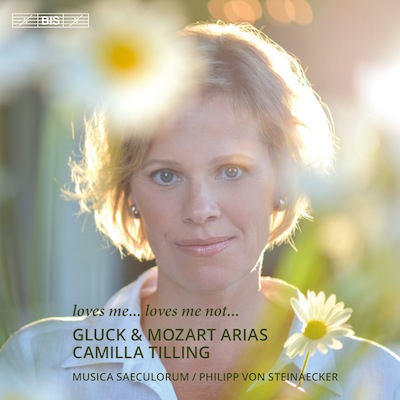
Camilla Tilling: “loves me… loves me not…”
Opera arias by Gluck and Mozart.
Musica Saeculorum,
Philipp von Steinaecker, conductor
SACD BIS-2234
Camilla Tilling grew up on a farm in a rural part of Sweden. Her parents sang in the local church choir. Hearing her parents sing with the choir when she was about six years of age, she later recalled thinking, “Well, this isn’t difficult. I could do the same.” There you go!
I have to confess that Ms. Tilling had not been on my radar screen before I saw a listing for her new SACD from BIS. But one can infer from the stratospheric level of her appearances over the past few years that she has a marvelous voice. From her management’s website: “Fresh from performances of Mendelssohn’s Elijah with the Gewandhausorchester Leipzig and Thomas Hengelbrock, Tilling has a busy concert diary ahead including returns to Teatro alla Scala for Beethoven’s Missa Solemnis under Bernard Haitink, the Berliner Philharmoniker for Mahler’s Symphony No.4 under Sir Simon Rattle, and the New York Philharmonic for Beethoven’s Symphony No.9 under Alan Gilbert.” Also: Brahms’ German Requiem with Andris Nelsons (Boston Symphony), Christoph von Dohnányi (New York Philharmonic), and Bernard Haitink (Tonhalle-Orchester Zürich); Bach’s Matthew Passion with Sir Simon Rattle (Berlin Philharmonic); and Bach’s B-minor Mass with Philippe Jordan (Vienna Philharmonic). Whew!
More, and sound samples, after the jump. Continue Reading →


